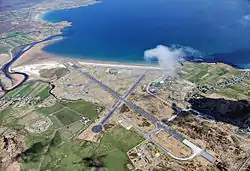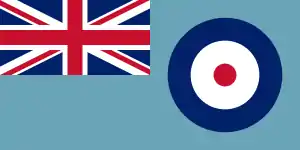RAF Stornoway
Royal Air Force Station Stornoway or more simply RAF Stornoway[1] is a former Royal Air Force station near the burgh of Stornoway, on the Isle of Lewis, in the Western Isles of Scotland. No. 112 Signals Unit Stornoway was also part of the RAF's activity on the airfield.
| RAF Stornoway | |||||||||
|---|---|---|---|---|---|---|---|---|---|
| Near Stornoway, Isle of Lewis, Outer Hebrides in Scotland | |||||||||
 An aerial view of the airfield at Stornoway | |||||||||
 RAF Stornoway Location in Outer Hebrides | |||||||||
| Coordinates | 58°13′07″N 006°19′53″W | ||||||||
| Type | Royal Air Force flying station | ||||||||
| Site information | |||||||||
| Owner | Ministry of Defence | ||||||||
| Operator | Royal Air Force | ||||||||
| Condition | Closed | ||||||||
| Site history | |||||||||
| Built | 1940 | ||||||||
| In use | 1 April 1941 – 1945 1982 – 31 March 1998 | ||||||||
| Fate | Transferred to civilian use and became Stornoway Airport. | ||||||||
| Airfield information | |||||||||
| Identifiers | IATA: SYY, ICAO: EGPO, WMO: 03026 | ||||||||
| Elevation | 26 metres (85 ft) AMSL | ||||||||
| |||||||||
History
Beginnings
The station was created in the Second World War on the site of a former golf course. It was home to various Coastal Command squadrons patrolling the North Atlantic for U-Boats. In late 1940, a detachment of Avro Anson aircraft arrived from No. 612 (County of Aberdeen) Squadron, Royal Auxiliary Air Force. The Ansons operated from the site of RAF Stornoway while it was still under construction. By November 1940, the aircraft from 612 Squadron had been posted to RAF Wick and were gradually replaced by Ansons from 48 Squadron RAF, based at RAF Hooton Park.
In March 1940, No. 827 Squadron RNAS operated Fairey Albacore aircraft from Stornoway in conjunction with the Ansons of 48 Squadron on maritime patrols across the Atlantic. This continued until the station was completed at which point they moved away. RAF Stornoway was officially constituted on 1 April 1941 as part of No.15 (Reconnaissance) Group,[2] and then No.18 (Reconnaissance) Group, both of RAF Coastal Command but was finally closed down at the end of the Second World War when it reverted to Stornoway Airport. No. 66 Air-Sea Rescue (ASR) Marine Craft Unit was also based out of Stornoway Harbour during 1943 and 1944.[3]
Post War
In 1952 biological agents were brought in to the airport from MRD airport in Mérida, Venezuela for the controversial Operation Cauldron.[4] They were testing the dangerous agents on caged monkeys and guinea pigs who were situated on a navy pontoon nearby at the Braighe.[5] The tests were carried out by scientists from the Chemical and Biological Defence Establishment (CBDE) from Porton Down. When a trawler inadvertently passed through one of the clouds of plague bacteria, the ship and crew were temporarily put under covert surveillance during their return from Iceland to Blackpool and onshore. CBDE was later amalgamated and now forms part of the Defence Science and Technology Laboratory. Porton Down has encountered controversy for human experimentation using chemical warfare right up until 1990.[6]
The Cold War
During the height of the Cold War years Stornoway Airport was home to 112 S.U., an RAF Signals Unit[7] that was established in 1960 as an Electronic countermeasures (ECM) measurement and evaluation unit by RAF Bomber Command Headquarters (HQBC), High Wycombe. The unit measured the signal strength, frequency bandwidths and aerial performance of the operational Handley Page Victor and Avro Vulcan V bombers as they flew a course towards, over or away from the unit varying from straight-lines to polar patterns.[8] Results were passed back to Operations Research Branch, (HQBC), BCDU at RAF Finningley and each aircraft's base for the Electronics Engineers and Technicians to review for performance improvement of each piece of equipment that was measured.[7] The combined success of 112 S.U., BCDU at RAF Finningly and each of the aircraft's bases along with the Operations Research Branch at (HQBC) and technical support from RRE Malvern (later to become RSRE Malvern) was demonstrated by the V-force during the Operation Skyshield exercises [9] and readiness through the Cuban Missile Crisis in the early sixties [10] and subsequent exercises[11] up to the time that the unit was closed in 1983.
In the early 1980s, part of the Airport was upgraded in a £40 million upgrade and extension of the main runway and taxiways along with new hangars, to accept Panavia Tornado aircraft.[12] By 1 April 1982 this work was completed, the buildings commissioned and RAF Stornoway was established once again in order to become a Forward Operations Base. After sixteen years in this role and also the end of the Cold War, the station was finally closed[13] on 31 March 1998 and reverted to Stornoway Airport.
After this some of the buildings were sold off, one becoming a Christian school, and others including the Nissen hut accommodation blocks were demolished. The runway remains in use as part of Stornoway Airport, and other parts of the site are used as a ground for holding stunt shows and vehicle exhibitions.
Units
| Squadron | Aircraft | From | To | To | Notes |
|---|---|---|---|---|---|
| 48 | Avro Anson I Bristol Beaufort I Lockheed Hudson V/III | 16 July 1940 | 3 August 1941 | RAF Stornoway | As a detachment from RAF Hooton Park.[14] |
| 48 | Avro Anson I Bristol Beaufort I Lockheed Hudson V/III | 3 August 1941 | 20 October 1941 | RAF Skitten | Detachments at RAF Aldergrove and RAF Limavady.[14] |
| 58 | Armstrong Whitworth Whitley V/VII | 30 August 1942 | 2 December 1942 | RAF Holmsley South | [15] |
| 58 | Handley Page Halifax II/III | 1 September 1944 | 25 May 1945 | Disbanded | [15] |
| 224 | Lockheed Hudson III/V | 19 February 1942 | 16 April 1942 | RAF Tiree | As a detachment from RAF Limavady.[16] |
| 500 | Lockheed Hudson V | 22 March 1942 | 30 August 1942 | RAF St Eval | [17] |
| 502 | Handley Page Halifax II/III | 14 September 1944 | 25 May 1945 | Disbanded | [18] |
| 518 | Handley Page Halifax V | 6 July 1943 | 25 September 1943 | RAF Tiree | [18] |
| 612 | Avro Anson I | June 1939 | November 1940 | RAF Wick | As a detachment from RAF Dyce.[19] |
RAF Stornoway in fiction
RAF Stornoway is featured in the Tom Clancy novel, Red Storm Rising, as a base for RAF operations over the North Atlantic and against Soviet-held Iceland. Later the displaced carrier air wing from USS Nimitz is based there after the carrier sustains battle damage. Also mentioned in passing in Katherine Kurtz's Death of an Adept.
See also
- Electronic countermeasures
- Electronic warfare
References
Notes
Citations
- Jefford 2001, p. 166.
- Barrass, M. B. (2011). "A History of RAF Organisation : Groups 10–19". rafweb.org. Archived from the original on 5 October 2013. Retrieved 7 October 2013.
- Roskill, Stephen Wentworth. The War at Sea, 1939–1945, Volume 1, pp. 332–333. H. M. Stationery Office, 1954.
- Wheelis, Mark; Lajos Rózsa; Malcolm Dando (2006). Deadly Cultures: Biological Weapons since 1945. Harvard University Press. pp. 56–7. ISBN 0-674-01699-8.
- Fenton, Ben (20 September 2005). "Trawler steamed into germ warfare site and no one said a word". Daily Telegraph. London. Retrieved 20 May 2010.
- https://www.amazon.co.uk/Gassed-Behind-Scenes-Porton-Down/dp/1842320718/ref=sr_1_1?s=books&ie=UTF8&qid=1362268143&sr=1-1
- http://discovery.nationalarchives.gov.uk/SearchUI/details/C11041126?descriptiontype=Full&ref=AIR+29/4526
- Document AIR 29/4736 1974–1980, The National Archives, Kew.
- Document AIR 14/4317 Monitoring of RED SHRIMP performance before Exercise SKYSHIELD II, The National Archives, Kew.
- White, p 47.
- Hennessy, p.201
- Horseman, Martin, ed. (March 1982). "New Air Base at Stornoway". Armed Forces. Shepperton: Ian Allan. p. 47. ISSN 0142-4696.
- http://www.heraldscotland.com/sport/spl/aberdeen/raf-to-withdraw-from-stornoway-next-month-1.354520
- Jefford 1988, p. 41.
- Jefford 1988, p. 43.
- Jefford 1988, p. 73.
- Jefford 1988, p. 94.
- Jefford 1988, p. 95.
- Jefford 1988, p. 100.
Bibliography
- Jefford, C.G. RAF Squadrons, a Comprehensive Record of the Movement and Equipment of all RAF Squadrons and their Antecedents since 1912. Shrewsbury, Shropshire, UK: Airlife Publishing, 1988. ISBN 1-84037-141-2.
- White, Roland. (2007). Vulcan 607, The epic story of the most remarkable air attack since WWII. UK: Corgi Books. ISBN 978-0-552-15229-7.
- Brookes, Andrew (2009). Vulcan Units of the Cold War. UK: Osprey Publishing. ISBN 978-1-84603-297-4.
- Brookes, Andrew (2011). Victor Units of the Cold War. UK: Osprey Publishing. ISBN 978-1-84908-339-3.
- Hennessy, Peter (2010). The Secret State, Preparing for the worst 1945-2010. UK: Penguin Books. ISBN 978-0-141-04469-9.
Further reading
- Hamilton-Paterson, James. (2013). Under the Radar. UK: Faber and Faber Limited. ISBN 978-0-571-27398-0.
- Robinson, Derek. (2008). Hullo Russia, Goodbye England. UK: MacLehose Press. ISBN 978-0-85705-092-2.
External links
| Wikimedia Commons has media related to RAF Stornoway. |

